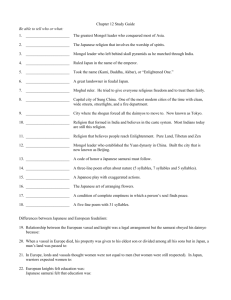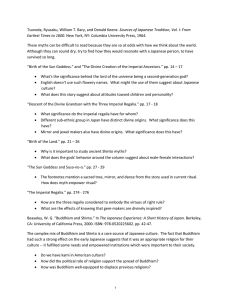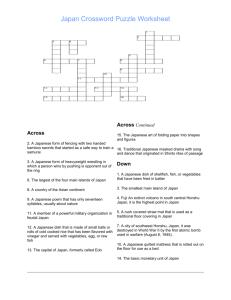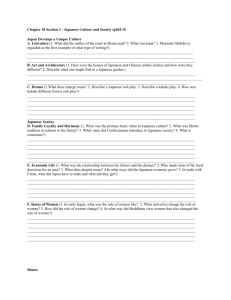Study Guide for Japan Unit
advertisement
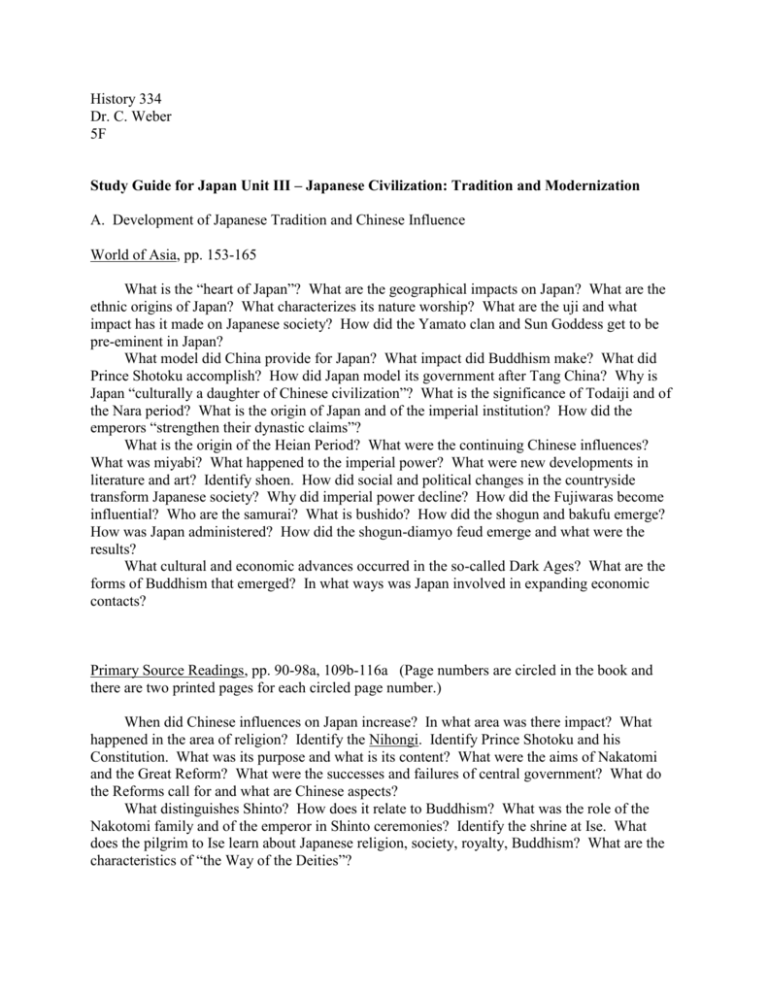
History 334 Dr. C. Weber 5F Study Guide for Japan Unit III – Japanese Civilization: Tradition and Modernization A. Development of Japanese Tradition and Chinese Influence World of Asia, pp. 153-165 What is the “heart of Japan”? What are the geographical impacts on Japan? What are the ethnic origins of Japan? What characterizes its nature worship? What are the uji and what impact has it made on Japanese society? How did the Yamato clan and Sun Goddess get to be pre-eminent in Japan? What model did China provide for Japan? What impact did Buddhism make? What did Prince Shotoku accomplish? How did Japan model its government after Tang China? Why is Japan “culturally a daughter of Chinese civilization”? What is the significance of Todaiji and of the Nara period? What is the origin of Japan and of the imperial institution? How did the emperors “strengthen their dynastic claims”? What is the origin of the Heian Period? What were the continuing Chinese influences? What was miyabi? What happened to the imperial power? What were new developments in literature and art? Identify shoen. How did social and political changes in the countryside transform Japanese society? Why did imperial power decline? How did the Fujiwaras become influential? Who are the samurai? What is bushido? How did the shogun and bakufu emerge? How was Japan administered? How did the shogun-diamyo feud emerge and what were the results? What cultural and economic advances occurred in the so-called Dark Ages? What are the forms of Buddhism that emerged? In what ways was Japan involved in expanding economic contacts? Primary Source Readings, pp. 90-98a, 109b-116a (Page numbers are circled in the book and there are two printed pages for each circled page number.) When did Chinese influences on Japan increase? In what area was there impact? What happened in the area of religion? Identify the Nihongi. Identify Prince Shotoku and his Constitution. What was its purpose and what is its content? What were the aims of Nakatomi and the Great Reform? What were the successes and failures of central government? What do the Reforms call for and what are Chinese aspects? What distinguishes Shinto? How does it relate to Buddhism? What was the role of the Nakotomi family and of the emperor in Shinto ceremonies? Identify the shrine at Ise. What does the pilgrim to Ise learn about Japanese religion, society, royalty, Buddhism? What are the characteristics of “the Way of the Deities”? 2 B. Medieval Japan and National Isolation World of Asia, pp. 165-175 Who are the three unifiers of Japan and what did each accomplish? What class structure emerged? How was the Tokugawa shogunate founded? What is bakufu? What characterized the centralized feudalism of leyasu? What role did the “alternate attendance” system play? What was the purpose of Nijo castle? What is the significance of the ronin and what happened to them? When and why did Europeans first come to Japan? What role did the missionaries play? How did leyasu respond to them? What events closed Japan’s Christian century? What was Sakoku? What privilege was given the Dutch? How did Japan’s seclusion prepare it for modernization? What role did Neo-Confucianism play? What economic and social changes occurred? What role did the merchant class play? What happened to the peasants? the samurai? What is Dutch Learning and its impact? What characterized the new urban culture and ukiyo? Identify haiku, bunraku, kabuki. What is the moral of the story of the 47 Ronin? What countries were interested in opening Japan? How did the US become involved with Japan? Primary Source Readings, pp. 98b-109a, 116a-121 (circled page numbers) How did the Fujiwara family control Japanese government and imperial rule? Who is Michinaga and what do we learn about him in The Great Mirror? What situation develops in the provinces? What are the circumstances which lead to the creation of the shogunate? What do we learn of Yoritomo and Yorimasa? What does one find of popular culture and religion in Tale of the House of Taira as well as of aristocratic life? Why was Buddhism attractive to Japanese and how did it enter and become established in Japan? Characterize Tendai and Zen. What characterized popular Buddhism? Identify Genshin, Honin, and Shinran. How does the Nihongi explain the introduction of Buddhism to Japan and what is its attractiveness? What role does Shinto play? What does Genshin indicate are the morals and ethics espoused by Buddhism? How does he characterize Paradise (Pure Land) and hell? What is nembutsu? What are the characteristics of Amitabha? How is he worshiped? 3 C. The Rise of Japan in the Modern World World of Asia, pp. 176-230 How did Perry and Harris open Japan and why did the Japanese agree? What was the nature of the struggle between the “nationalists” and the bakufu? What caused the fall of the Tokugawa? when? What did the new Emperor Meiji accomplish? What did the modernizing samurai do? How did the genro use the emperor and treat the diamyo and samurai? What did the Satsuma Rebellion achieve? How did Japan modernize? What is the origin and role of zaibatsu? What impact did education make in modernization? How did the 1889 Constitution organize the government and also maintain the authoritarian tradition? Why did Japan undertake foreign expansion? What were the reasons for and the results of the Sino-Japanese war? Why did Japan align with Britain rather than Russia? What were the outcomes of the Russo-Japanese War? How did Japan expand in the early 20th century? What were the Twenty-One Demands? Why was Japan upset with the US? What was the impact of the Washington Conference? Who controlled the Japanese government and how did factions vary? What were the problems in the rural and urban sectors? What characterized “Japan’s evolution to an urbancentered society” and its efforts at democracy in the 1920s? What is kokutai? What were the sources of rural discontent? What instigated Japanese expansion and what opportunities did they seize? What made war inevitable? How did the tide of the war go against Japan? What was the nature of the surrender? What were MacArthur’s objectives as SCAP? What Japanese values aided his cause? What reforms were initiated? What is Article IX? What is the meaning of “Yankee shogun”? What is the Security Treaty? What were Japan’s successes and problems between 1945-80? What were the causes of student unrest? Where has the LDP gotten its support? What have been its successes and problems? What have been issues between Japan and China and the US? When did Japan experience its economic surge and what were the causes of its “economic miracle”? What did opponents say about these policies? What explanations are given for Japan’s growth after 1960? What caused the downturn? What is on and giri and how do they lead to a different basis for morality than in the West? Identify the three main minorities and their treatment. What characterizes Japanese education? religion? sport? crime and Yakuza? What are the significant scandals? What has happened with the imperial family? What have been the main issues in US-Japan relations? What is the Northern Territorial issue between Japan and Russia? What is the textbook controversy? What have relations with China and the Koreas been like? Note terms on pp. 228-230. 4 Primary Source Readings, pp. 122-127 (circled page numbers) “The Church in Japan,” by Yoshiaki Yu How did Christianity first come to Japan? How was it reintroduced and what groups were involved? Identify “bands” and Mukyo-kai. What were the reactions to Christianity in the late 19th century? What changes happened to Christianity in the first half of the 20th? What is the Kyodan? How has the church fared in Japan since WWII (new groups and movements, etc.)? What has transpired recently regarding Protestants and Catholics, evangelicals vs. non-evangelicals, indigenization, makeup of the congregations, and the church’s role in society?



